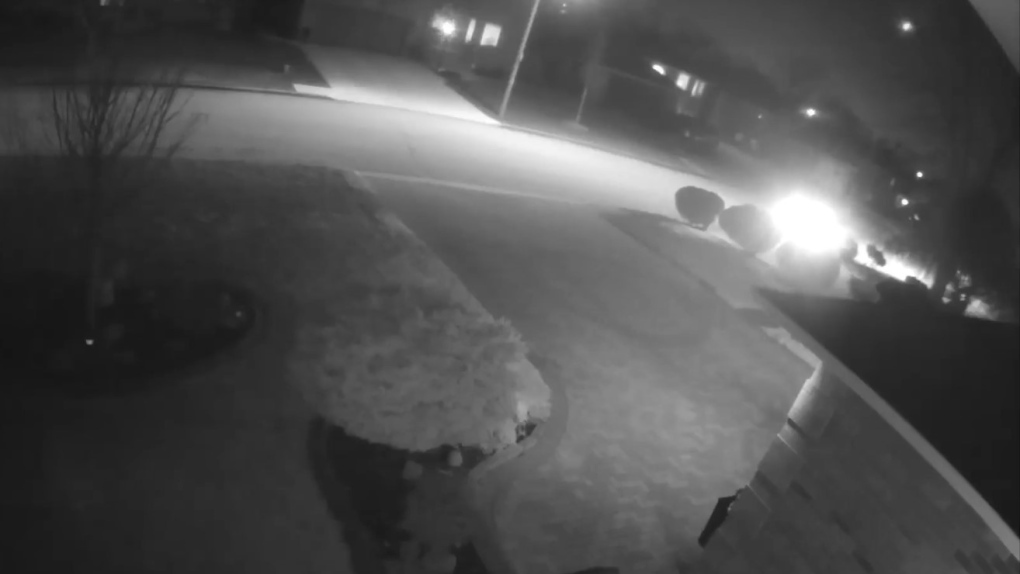Bright green fireball spotted in southwestern Ontario
 Meteor fireball over Michigan on Sunday, Feb. 19, 2023. (Source: The Zorr/YouTube)
Meteor fireball over Michigan on Sunday, Feb. 19, 2023. (Source: The Zorr/YouTube)
There are several reports of a bright green fireball seen in southwestern Ontario, and as far away as Wisconsin, Michigan, Ohio and Indiana.
University of Windsor astronomer Steve Pellarin said the reports came in around 8:50 p.m. on Sunday from Windsor, London, Ont., and several states.
He said it was a bright green colour, half as bright as a full moon, but much brighter than the brightest star-like object in the sky (planet Venus). Most reports estimate the visual magnitude at around -11.
“Appears to have been visible for 3.5 seconds fairly low over the western horizon heading west (downward toward horizon)," he said. "Captured by several home security cameras."
A video of the fireball was posted on YouTube from Michigan.
Windsor resident Angelo Tiseo was also caught the fireball on his home security camera.
 Windsor resident Angelo Tiseo was one of the people who caught the fireball on his home security camera. (Source: Angelo Tiseo)
Windsor resident Angelo Tiseo was one of the people who caught the fireball on his home security camera. (Source: Angelo Tiseo)
“As there are no current regular meteor showers that are active, it is likely that this meteor was what we call a 'sporadic' or random meteor, that approached the Earth from the direction basically opposite to the sun,” said Pellarin.
He added it would have been probably about the size of a large pebble or stone that could fit into a pill bottle.
Pellarin said the greenish colour that was seen probably indicates that this rock contained a fair bit of nickel in it, as many meteoroids contain the metals iron and nickel and nickel atoms glow bright green when they are superheated by the friction with molecules in Earth's atmosphere as they plow through it.
“A piece may have survived to hit the ground, but often the heat of entry into the earth's atmosphere expands the rock and breaks it into dust,” said Pellarin. “The Earth is estimated to absorb almost 14 tons of meteor dust every day!”
He said it did not appear to explode at the end of its visibility and that it likely broke up well up in the atmosphere, perhaps 12 to 27 kilometres up.
Here is a website that people can report their fireball observations to https://ams.imo.net/members/imo/report_intro/. These reports can actually be used by astronomers to determine the trajectory and orbits that these object had and potential and locations where debris may have landed. Pellarin said the reports are useful in doing real science.
CTVNews.ca Top Stories

LIVE UPDATES Toronto's first 'Eras Tour' show kicks off at Rogers Centre
Taylor Swift takes the stage at the Rogers Centre as 'The Eras Tour' has arrived.
Purolator workers won't handle Canada Post packages if strike occurs, union says
Teamsters Canada says if Canada Post workers go on strike or are locked out, its members at Purolator won't handle any packages postmarked or identified as originating from the carrier.
Trump chooses anti-vaccine activist Robert F. Kennedy Jr. as health secretary
U.S. President-elect Donald Trump says he will nominate anti-vaccine activist Robert F. Kennedy Jr. to lead the Department of Health and Human Services, putting him in charge of a massive agency that oversees everything from drug, vaccine and food safety to medical research and the social safety net programs Medicare and Medicaid.
Canada urged to cut government-funded research collaborations with China: report
A newly released report is urging Canada to immediately end all government-funded research collaborations with China in a variety of different areas.
Centre Block renovation facing timeline and budget 'pressures'
The multi-billion-dollar renovation of parliament’s Centre Block building continues to be on time and on budget, but construction crews are facing 'pressures' when it comes to the deadline and total costs, according to the department in charge of the project.
Winnipeg driver rescues passengers from burning van
A Winnipeg driver was in the right place at the right time when a paratransit van caught fire Thursday morning.
B.C.'s chief vet tells clinics to set up bird flu protocols amid human exposure risk
British Columbia's chief veterinarian has told clinics that treat wild birds that they must establish protocols to prevent the spread of avian flu, warning of the risk of human exposure to the illness.
Measles cases in New Brunswick continue to climb
The number of measles cases in New Brunswick continue to climb. Officials with New Brunswick’s Department of Health said as of Thursday, the number of confirmed cases since October has reached 43.
Police release bodycam video of officer-involved incident at Hindu temple protest in Brampton, Ont.
Police say an officer who forcefully removed a 'weapon' from a protester outside of a Hindu temple in Brampton was acting 'within the lawful execution of his duties' after bystander video of the incident circulated widely online.































